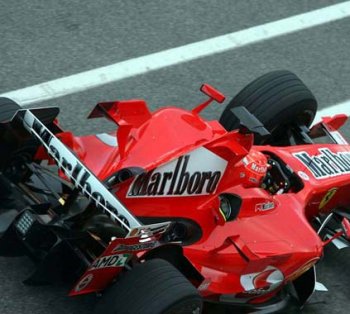|
The arrival on
track last week of the new 2006 Ferrari 248 F1 Grand Prix
machine marked
the culmination of an intense development period in which
Shell played a pivotal role. At the new car's heart is an
all-new Formula One V8 engine that is central to the team's
hopes for another World Championship title this year.
The new Ferrari
V8 engine was developed and built in record time. Sweeping
technical rule changes announced by the FIA last spring
spelled the end of the V10 era. While still allowed with
rev-limits, the 3.0-litre V10 gives way this year to a new
crop of V8 engines limited to 2.4-litres in displacement.
Since May 2005 when the Ferrari development programme began,
Shell engineers have worked alongside Ferrari to bring the
Scuderia's new engine into fruition. "This is the biggest
technical change since we renewed our partnership with
Ferrari in 1996," said  Mike
Copson of Shell Global Solutions, who works alongside a team
of 40 engineers, chemists and technicians from Shell
supporting Ferrari. "We've been working hand-in-hand with
Ferrari since the beginning to ensure that the design is
optimised for performance and reliability." Mike
Copson of Shell Global Solutions, who works alongside a team
of 40 engineers, chemists and technicians from Shell
supporting Ferrari. "We've been working hand-in-hand with
Ferrari since the beginning to ensure that the design is
optimised for performance and reliability."
Through the
development, Shell engineers have gained a deep
understanding of the characteristics of the new V8
engine. The engine format is inherently different from the
V10s in terms of breathing characteristics, fuel economy,
lubrication demands and harmonics. "It's not just a matter
of scaling down a V10," Copson said. 'It's an entirely new
engine with a whole new set of limitations and opportunities
to explore. Understanding how it performs from the beginning
is vital in terms of the properties of our fuel formulation,
for example."
A key technical partner of Ferrari since 1996, Shell's
experienced motorsport team was well attuned to Ferrari's
uncompromising approach to development of the new engine and
the new 248 F1 car.
|
 |
|
Ferrari 248 F1: It's new 2.4-litre V8 engine was
developed and built in record time. |
|
|
 |
|
The arrival on
track last week of the new 2006 Ferrari 248 F1 car marked
the culmination of an intense development period in which
Shell played a pivotal role |
|
|
In its 10 years through from 2005, the partnership witnessed
one of Ferrari's most successful periods in its long Formula
One history, as well as one of the best reliability records
in the sport. The 248 F1 and new V8 engine programme
required technological innovation not only from Maranello
but from Shell, as well. Shell's team worked hard with
Ferrari to create the lubrication strategy not only for the
engine but for the gearbox, as well. "We didn't just focus
on the engine,' Copson said. 'Instead, it was a systems
approach that was intended to maximise the synergies of the
car's systems while minimising system (power) losses. Small
details down to optimising operating temperatures played a
role in the development process."
As the season opener approaches, the full effects of the
2006 rule changes are yet to be seen, but are the topic of
much speculation. With 20 percent less displacement, pundits
wonder whether this year's Formula One cars will have 20
percent lower horsepower, or whether some teams will be
successful in liberating more power from their new V8
engines. The impact of the new rules on fuel economy and pit
stop strategy is another major tactical consideration for
2006. Reliability will continue to be an important factor,
as the FIA has kept in place its one-engine-for-two-races
rule.
As Shell begins the second decade of its current partnership
with Ferrari, Shell has not yet revealed the formulations of
Shell V-Power fuel, Shell Helix oil and Shell Spirax gear
lubes which will be supplied to the team as the season
begins in Bahrain in March. Both partners are hoping to
extend their enviable string of performance and reliability
as this new era of Formula One competition begins.
|
|
|
|
![]()
![]()